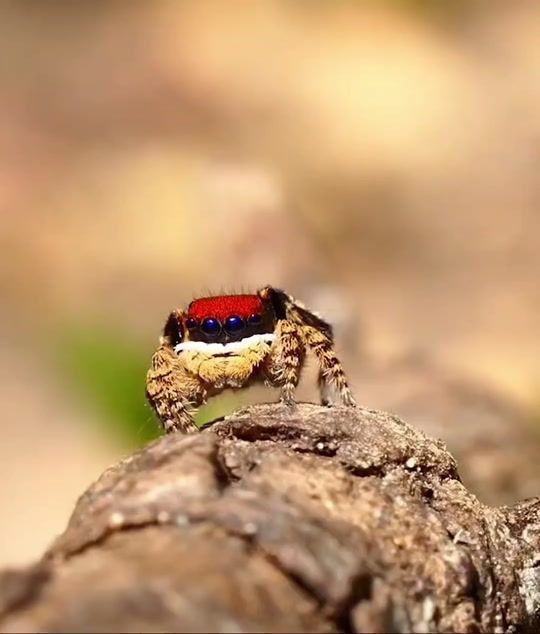The mystery of dancing spiders’ DNA is captivating scientists worldwide. Peacock spiders — tiny, pinhead-sized arachnids native to Australia — have long fascinated researchers and nature lovers with their dazzling colors, mesmerizing courtship dances, and unique drumming songs. But what has puzzled scientists even more is their staggering diversity.
Unlike most animal groups, which usually have five to ten species, there are already more than 100 known species of peacock spider, each with its own unique patterns, colors, and mating displays. Now, researchers believe they may have uncovered one of the secrets behind this extraordinary biodiversity: the spiders’ so-called “dark DNA.”
The Dazzling World of Peacock Spiders
Peacock spiders are renowned for their bright, iridescent abdomens and spectacular courtship rituals. During mating season, males put on an elaborate display, raising their colorful abdomens, waving their legs, and producing rhythmic vibrations — almost like a tiny spider dance party.
Each species has its own distinct choreography and even a unique “song,” created by drumming their feet against the ground. These performances are not just for show; they are critical for attracting mates and ensuring the survival of each species.
What makes this phenomenon even more fascinating is just how many different types of peacock spider exist, each with its own dance, song, and appearance. This led scientists to ask: how did so many distinct species evolve in such a relatively short amount of time?
Unlocking the Mystery: Dark DNA
The mystery of dancing spiders’ DNA revolves around the idea that something beyond traditional genes is driving their rapid diversification.
DNA is a long chain of molecules that contains the instructions for building and operating living things. Specific stretches of DNA, known as genes, control traits like eye color, height, or — in the case of spiders — leg length, abdominal patterns, and mating behaviors.
But most of an organism’s DNA does not code for traits at all. This non-coding portion is often called “junk DNA,” but scientists now prefer the term “dark DNA” because they suspect it may have hidden functions we don’t yet understand.
Peacock spiders have three times more dark DNA than humans, which may help explain their remarkable ability to evolve into so many different species.
Inside the Groundbreaking Research
Jonah Walker, a PhD researcher at the Sanger Institute, has been leading the effort to understand what makes peacock spiders so diverse. Together with Dr. Joana Meier and an international team, Walker traveled across Australia to collect specimens of every known peacock spider species.
The team carefully documented each spider’s dance moves, drumming patterns, and visual displays before sequencing their DNA. The next step was to match specific behaviors and physical traits with genetic differences — essentially creating a genetic blueprint of spider diversity.
“We are interested in how the spiders evolve to become that diverse,” Walker explained. “Peacock spiders are at the extreme end of species variation, so by studying them we can learn what processes drive that variation in general.”
The early results are intriguing. The researchers have found strong evidence that dark DNA — not just the genes themselves — plays a major role in shaping spider diversity. This could mean that the “in-between” regions of DNA help regulate when and how certain genes are activated, allowing spiders to adapt quickly to new environments and form new species over time.
Overcoming Fear for Science
Interestingly, Jonah Walker admitted that he used to have a fear of spiders before beginning his research.
“When I told friends and family that I was going to study spiders in Australia, they were worried — and so was I,” he said. “But after watching them dance just once, any fear I had disappeared. Their behavior is just too captivating.”
This personal connection has fueled his dedication to documenting and understanding these creatures, adding a human touch to the scientific work.
Why This Matters Beyond Spiders
The mystery of dancing spiders’ DNA is not just about solving an arachnid puzzle. It could have major implications for biology as a whole.
Dr. Meier, who has already decoded the DNA of more than 1,000 butterfly and moth species, believes that studying organisms with high levels of diversity will reveal general principles about evolution.
“By understanding the DNA of all the different organisms, we learn about the general principles of how genes work and what the function of dark DNA is,” she said. “This also helps us learn about ourselves.”
Indeed, humans and spiders share surprisingly similar DNA structures. Unlocking the purpose of dark DNA in spiders could eventually provide insights into human evolution, genetic diseases, and how species adapt to climate change.
The Earth BioGenome Project
This research is part of the Earth BioGenome Project, one of the most ambitious scientific efforts ever undertaken. Its goal is to decode the DNA of every single plant, animal, and fungus on Earth — around 1.8 million species — within the next decade.
So far, scientists have sequenced the DNA of 3,000 species, with a target of 10,000 for next year. By completing this work, researchers hope to create a comprehensive “library of life” that will revolutionize our understanding of evolution and ecology.
Peacock spiders are just one piece of this massive puzzle, but they may hold a key to understanding how biodiversity is generated and maintained.
A Window Into Evolution
The mystery of dancing spiders’ DNA is still being unraveled, but the clues are compelling. These tiny spiders — no larger than a pinhead — may teach us not only how they became so varied, but also how life on Earth itself keeps innovating and adapting.
With more research underway, scientists are hopeful that this work will not just explain the brilliance of peacock spiders, but also shed light on the hidden codes that shape life itself.
Source: BBC News



tm1nwa